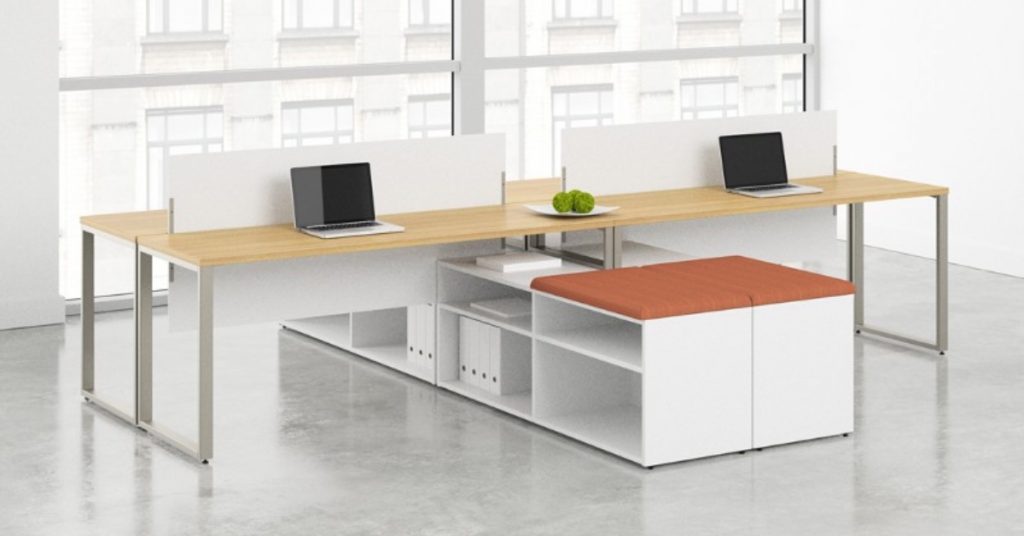Choosing Office Furniture That Promotes Inclusivity in Your Workplace
February 25, 2020
When you think about workplace inclusivity, the first thing that pops into your mind is…office furniture? Probably not. But when you’re employing people with disabilities, office furniture plays an important role in their success in the workplace.
Let’s Talk About Inclusivity
A broad term, inclusivity can include anything from race and ethnicity to sexual orientation, age, gender, health conditions, and much more. The focus of this article is on disabilities, both visible and invisible, which covers a wide range of conditions. Workplace inclusivity means creating a space in which anyone can work, regardless of disability.
Disabilities Aren’t Always Obvious

A visible disability may refer to someone who uses a walker for multiple sclerosis or a person with vision impairment who wears special glasses. Neurological conditions such as sensory perception disorder, autism spectrum disorder, and ADHD are invisible disabilities. So are mental health issues like anxiety and depression, along with chronic pain and other medical conditions.
Sensory Issues
Sensory overload affects people with many conditions, from autism to fibromyalgia to multiple sclerosis. For anyone with sensory issues, constant chatter, cell phone dings, and bright lights can be overwhelming and distracting. Depending on the needs of your team and the size of your space, consider these options:
- Create a quiet room. From calming colors to flexible seating and gentle lighting, this room serves to help people work peacefully or take a break when they need quiet. These Universal Design (UD) features can work for anyone on your team, whether it’s a person with sensory issues or a team member who needs silence to laser focus on a project.
- Designate a quiet space. If you can’t dedicate a room, create a space with ideal lighting and relaxing décor elements. Post signs for silencing cell phones and voices.
- Quiet hours. Talk to your team about choosing a chunk of time for quiet hours in the office. Choose an alternative space with closed doors like the conference room for meetings or small group discussions.
- Sensory kits. Gaining popularity in stadiums, schools, and other venues, sensory kits contain items that help block out noise and soothe anxiety. Make them available in your reception area for clients and guests, too!
Office Furniture for Everyone
Consider these furniture options for team members who need alternatives to traditional desks and seating.
Sit-to-Stand Desks
The health benefits have long been touted for standing or walking in the workplace. For some, sitting for hours can be excruciating or may not be an option. A sit-to-stand desk offers an alternative to a traditional desk.
Deskless office spaces are gaining popularity as more and more workers are demanding healthy workplace options!
Flexible Seating Options
Casual seating areas have been trending for quite a while. Create an alternative workspace to desks and cubicles by arranging comfortable couches and chairs with end tables. Pair seats of various heights with pouf stools. Casual spaces filled with innovative seating foster creativity and encourage team bonding, too!
Make stools, nesting chairs, and bungee chairs available in conference rooms, work stations, and eating areas so team members are comfortable no matter where they choose to work.
Do not overlook your reception or waiting area! Welcome everyone to your office with comfortable, attractive seats that make a statement about how much you value your clients and guests.
**Bonus Tip** Provide charging stations for phones and other devices throughout your office so team members can always stay connected!
Customized Spaces
A person with sensory issues may prefer a corner office space. A team member who uses a wheelchair may want to be centrally located in the building. Adjustable tables work well with wheelchairs and other specialized seating. Talk with individuals to find out how customized reasonable accommodations can help them succeed in your workplace.
Create a Culture of Inclusivity
- For your workspace to be truly inclusive, you need input from your team. An email survey or informal meeting can help provide you with feedback to create a workspace in which every employee thrives.
- Encourage openness. Health conditions and disabilities are extremely private. Yet more and more folks are opening up in the workplace. When you create an environment in which people are encouraged to share their challenges and enlist co-workers to help them become successful, people are much more likely to share!
- Educate and inform. Not everyone is knowledgeable about disabilities and the challenges they bring. Hold lunch-and-learns, company-wide seminars, or after-hours events to provide your team with valuable information on disabilities.
- Enlist your team in a cause! Nothing builds camaraderie like working together to help others.
Helpful Resources for Workplace Disabilities:
Americans with Disabilities Act
Job Accommodation Network (JAN)
Building a culture of inclusivity starts with giving team members what they need to be successful and thrive at work!
The furniture folks at Nolt’s are happy to help you select office furniture that meets the needs of your team! Stop by our showroom today!
